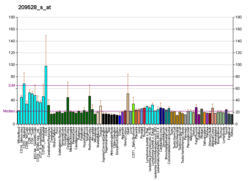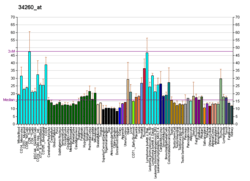TELO2
Telomere length regulation protein TEL2 homolog is a protein that in humans is encoded by the TELO2 gene.[5][6][7][8]
Function
In 2007, researchers reported an unexpected role for Tel2 in the expression of all mammalian phosphatidylinositol 3-kinase-related protein kinases (PIKKs). Although Tel2 was identified as a budding yeast gene required for the telomere length maintenance, they found no obvious telomeric function for mammalian Tel2. Tel2 deletion also curbed mTOR signaling, indicating that Tel2 affects mammalian PIKKs. Tel2 binds to part of the HEAT repeat segments of ATM and mTOR, and is a highly conserved regulator of PIKK stability.[9]
gollark: Somewhat.
gollark: GPT-3 can apparently already pass as a human at writing blog posts and reddit comments.
gollark: Or just random wikipedia pages for animals.
gollark: I haven't heard anyone doing it.
gollark: I don't really like consoles anyway, so meh.
References
- GRCh38: Ensembl release 89: ENSG00000100726 - Ensembl, May 2017
- GRCm38: Ensembl release 89: ENSMUSG00000024170 - Ensembl, May 2017
- "Human PubMed Reference:". National Center for Biotechnology Information, U.S. National Library of Medicine.
- "Mouse PubMed Reference:". National Center for Biotechnology Information, U.S. National Library of Medicine.
- Ishikawa K, Nagase T, Suyama M, Miyajima N, Tanaka A, Kotani H, Nomura N, Ohara O (Dec 1998). "Prediction of the coding sequences of unidentified human genes. X. The complete sequences of 100 new cDNA clones from brain which can code for large proteins in vitro". DNA Res. 5 (3): 169–76. doi:10.1093/dnares/5.3.169. PMID 9734811.
- Wiemann S, Weil B, Wellenreuther R, Gassenhuber J, Glassl S, Ansorge W, Bocher M, Blocker H, Bauersachs S, Blum H, Lauber J, Dusterhoft A, Beyer A, Kohrer K, Strack N, Mewes HW, Ottenwalder B, Obermaier B, Tampe J, Heubner D, Wambutt R, Korn B, Klein M, Poustka A (Mar 2001). "Toward a catalog of human genes and proteins: sequencing and analysis of 500 novel complete protein coding human cDNAs". Genome Res. 11 (3): 422–35. doi:10.1101/gr.GR1547R. PMC 311072. PMID 11230166.
- Jiang N, Benard CY, Kebir H, Shoubridge EA, Hekimi S (Jun 2003). "Human CLK2 links cell cycle progression, apoptosis, and telomere length regulation". J Biol Chem. 278 (24): 21678–84. doi:10.1074/jbc.M300286200. PMID 12670948.
- "Entrez Gene: TELO2 TEL2, telomere maintenance 2, homolog (S. cerevisiae)".
- Takai H, Wang R, Takai K, Yang H, De Lange T (2007). "Tel2 Regulates the Stability of PI3K-Related Protein Kinases". Cell. 131 (7): 1248–1259. doi:10.1016/j.cell.2007.10.052. PMID 18160036.
Further reading
- Daniels RJ, Peden JF, Lloyd C, et al. (2001). "Sequence, structure and pathology of the fully annotated terminal 2 Mb of the short arm of human chromosome 16". Hum. Mol. Genet. 10 (4): 339–52. doi:10.1093/hmg/10.4.339. PMID 11157797.
- Simpson JC, Wellenreuther R, Poustka A, et al. (2001). "Systematic subcellular localization of novel proteins identified by large-scale cDNA sequencing". EMBO Rep. 1 (3): 287–92. doi:10.1093/embo-reports/kvd058. PMC 1083732. PMID 11256614.
- Strausberg RL, Feingold EA, Grouse LH, et al. (2003). "Generation and initial analysis of more than 15,000 full-length human and mouse cDNA sequences". Proc. Natl. Acad. Sci. U.S.A. 99 (26): 16899–903. doi:10.1073/pnas.242603899. PMC 139241. PMID 12477932.
- Ota T, Suzuki Y, Nishikawa T, et al. (2004). "Complete sequencing and characterization of 21,243 full-length human cDNAs". Nat. Genet. 36 (1): 40–5. doi:10.1038/ng1285. PMID 14702039.
- Ballif BA, Villén J, Beausoleil SA, et al. (2005). "Phosphoproteomic analysis of the developing mouse brain". Mol. Cell. Proteomics. 3 (11): 1093–101. doi:10.1074/mcp.M400085-MCP200. PMID 15345747.
- Stelzl U, Worm U, Lalowski M, et al. (2005). "A human protein-protein interaction network: a resource for annotating the proteome". Cell. 122 (6): 957–68. doi:10.1016/j.cell.2005.08.029. hdl:11858/00-001M-0000-0010-8592-0. PMID 16169070.
- Ewing RM, Chu P, Elisma F, et al. (2007). "Large-scale mapping of human protein-protein interactions by mass spectrometry". Mol. Syst. Biol. 3 (1): 89. doi:10.1038/msb4100134. PMC 1847948. PMID 17353931.
External links
This article is issued from Wikipedia. The text is licensed under Creative Commons - Attribution - Sharealike. Additional terms may apply for the media files.





